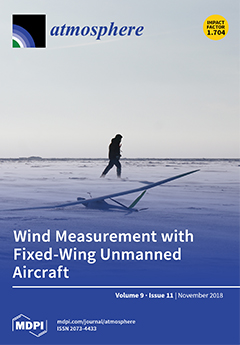Climate modification by stratospheric SO
2 injections, to form sulfate aerosols, may alter the spectral and angular distributions of the solar ultraviolet and visible radiation that reach the Earth’s surface, with potential consequences to environmental photobiology and photochemistry. We used modeling results from
[...] Read more.
Climate modification by stratospheric SO
2 injections, to form sulfate aerosols, may alter the spectral and angular distributions of the solar ultraviolet and visible radiation that reach the Earth’s surface, with potential consequences to environmental photobiology and photochemistry. We used modeling results from the CESM1(WACCM) stratospheric aerosol geoengineering large ensemble (GLENS) project, following the RCP8.5 emission scenario, and one geoengineering experiment with SO
2 injections in the stratosphere, designed to keep surface temperatures at 2020 levels. Zonally and monthly averaged vertical profiles of O
3, SO
2, and sulfate aerosols, at 30 N and 70 N, served as input into a radiative transfer model, to compute biologically active irradiances for DNA damage (
iDNA), UV index (UVI), photosynthetically active radiation (PAR), and two key tropospheric photodissociation coefficients (
jO1D for O
3 + hν (λ < 330 nm) → O(
1D) + O
2; and
jNO2 for NO
2 + hν (λ < 420 nm) → O(
3P) + NO). We show that the geoengineering scenario is accompanied by substantial reductions in UV radiation. For example, comparing March 2080 to March 2020,
iDNA decreased by 25% to 29% in the subtropics (30 N) and by 26% to 33% in the polar regions (70 N); UVI decreased by 19% to 20% at 30 N and 23% to 26% at 70 N; and
jO1D decreased by 22% to 24% at 30 N and 35% to 40% at 70 N, with comparable contributions from sulfate scattering and stratospheric O
3 recovery. Different responses were found for processes that depend on longer UV and visible wavelengths, as these are minimally affected by ozone; PAR and
jNO2 were only slightly lower (9–12%) at 30 N, but much lower at 70 N (35–40%). Similar reductions were estimated for other months (June, September, and December). Large increases in the PAR diffuse-direct ratio occurred in agreement with previous studies. Absorption by SO
2 gas had a small (~1%) effect on
jO1D,
iDNA, and UVI, and no effect on
jNO2 and PAR.
Full article





